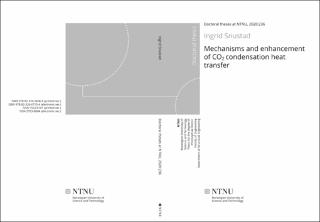| dc.contributor.advisor | Zhang, Zhiliang | |
| dc.contributor.advisor | He, Jianying | |
| dc.contributor.advisor | Brunsvold, Amy | |
| dc.contributor.advisor | Ervik, Åsmund | |
| dc.contributor.author | Snustad, Ingrid | |
| dc.date.accessioned | 2021-06-14T09:51:58Z | |
| dc.date.available | 2021-06-14T09:51:58Z | |
| dc.date.issued | 2021 | |
| dc.identifier.isbn | 978-82-326-6715-4 | |
| dc.identifier.issn | 2703-8084 | |
| dc.identifier.uri | https://hdl.handle.net/11250/2759221 | |
| dc.description.abstract | The aim of this thesis is to increase the understanding of the mechanisms governing Carbon Dioxide (CO2) condensation, and in that way finding a pathway towards a higher condensation efficiency. Liquefaction of CO2 occurs e.g. in industrial processes such as in heat exchangers for thermal management. Compact geometries have become increasingly important in thermal management following the decrease in size of electronic equipment. CO2 is a suitable solution as a refrigerant in such heat exchangers due to its thermophysical properties. It is also a viable substitute as a refrigerant in conventional heat transfer equipment in the quest for eliminating fluorine based refrigerants, due to their negative environmental impact. Liquefaction of CO2 also occurs when processing the gas prior to ship transportation of CO2 being captured from e.g. power plant exhaust. Reduction of the anthropogenic emissions of CO2 is required for reducing the global warming and achieving the 2-degree scenario set forth by the International Panel of Climate Change.
The main reason for resistance to heat transfer during condensation is the restricted conduction through the condensate film that is formed on the condenser surface. The research on more efficient condensation currently focuses on suppressing the formation of this condensate film and in stead achieving dropwise condensation. An introduction of droplets on the surface will reduce the heat transfer resistance and a more efficient condensation process emerges. The condensation heat transfer coefficient could be increased by up to an order of magnitude. For CO2 this alternative has not yet been considered and the research on CO2 condensation has hitherto focused on understanding how the flow properties affects the heat transfer in flow condensation inside tubes and channels. These are relevant geometries for heat exchangers and the flow in microchannels must be deciphered to gain control of the condensation in compact equipment. The condensation of CO2 on flat and structured surfaces has, however, not yet been studied, and the models for predicting the behavior do not include the influence of condenser material or surface structures on the heat transfer. We have through this work tried to answer if condensation of CO2 could be achieved in the dropwise mode, and if not, how the efficiency of CO2 condensation otherwise can be increased. We have also explored how the condenser material and/or surface structures influence the heat transfer during condensation.
For solving these issues we have designed a methodology and built an experimental facility for measuring the CO2 condensation heat transfer coefficient on various sur faces. By achieving elevated pressures and low temperatures CO2 has been liquefied on vertical surfaces and the heat transfer has been measured.
We have in this work established a first set of experimental data for CO2 condensation on vertical walls. We have found that surface properties such as roughness and surface energy affect the condensation heat transfer. With surface roughness, the material’s thermal conductivity also comes into play, as the uniformity of the temperature within the liquid will be influenced by the conductivity of the peaks of the material when the liquid film is thin. We have also found that structuring the surface with micro- and nanosized features will alter the heat transfer efficiency. A combination of micro- and nanostructures could result in a thinner liquid film on the surface, consequently reducing the heat transfer resistance through the condensate. On the other hand, the structures could also cause significant liquid retention and therefore a thicker liquid film. The results indicate that a careful design and fabrication of a combination of micro- and nanostructures will enhance the condensation heat transfer by increasing the surface area, reducing liquid retention and increasing the effective thermal conductivity of the composite surface of liquid and nanostructures similar to wicking condensation.
The results in this thesis show that there are pathways to increasing condensation heat transfer of CO2, which will lead to reduced costs and energy demands of the liquefaction process. Two main parameters have been identified: 1) roughness control and 2) optimization potentials for structured surfaces. This will result in e.g. lower CO2 transport costs during carbon capture and storage, and in improved thermal management of small electronic devices. | en_US |
| dc.language.iso | eng | en_US |
| dc.publisher | NTNU | en_US |
| dc.relation.ispartofseries | Doctoral theses at NTNU;2020:236 | |
| dc.relation.haspart | Paper 1: Snustad, Ingrid; Røe, Ingeborg Treu; Brunsvold, Amy; Ervik, Åsmund; He, Jianying; Zhang, Zhiliang. A review on wetting and water condensation - perspectives for CO2 condensation. Advances in Colloid and Interface Science 2018 ;Volum 256. s. 291-304 https://doi.org/10.1016/j.cis.2018.03.008 | en_US |
| dc.relation.haspart | Paper 2: Snustad, Ingrid; Ervik, Åsmund; Austegard, Anders; Brunsvold, Amy; He, Jianying; Zhang, Zhiliang. Heat transfer characteristics of CO2 condensation on common heat exchanger materials, method development and experimental results. Experimental Thermal and Fluid Science 2021 https://doi.org/10.1016/j.expthermflusci.2021.110440 This is an open access article under the CC BY license (http://creativecommons.org/licenses/by/4.0/). | en_US |
| dc.relation.haspart | Paper 3: Snustad, Ingrid; Hollund, Lene; Ervik, Åsmund; Austegard, Anders; Brunsvold, Amy; He, Jianying; Zhang, Zhiliang. Condensation heat transfer of CO2 on Cu based hierarchical and nanostructured surfaces. International Journal of Heat and Mass Transfer 2021 ;Volum 175. https://doi.org/10.1016/j.ijheatmasstransfer.2021.121367 | en_US |
| dc.title | Mechanisms and enhancement of CO2 condensation heat transfer | en_US |
| dc.type | Doctoral thesis | en_US |
| dc.subject.nsi | VDP::Technology: 500::Building technology: 530::Construction technology: 533 | en_US |
